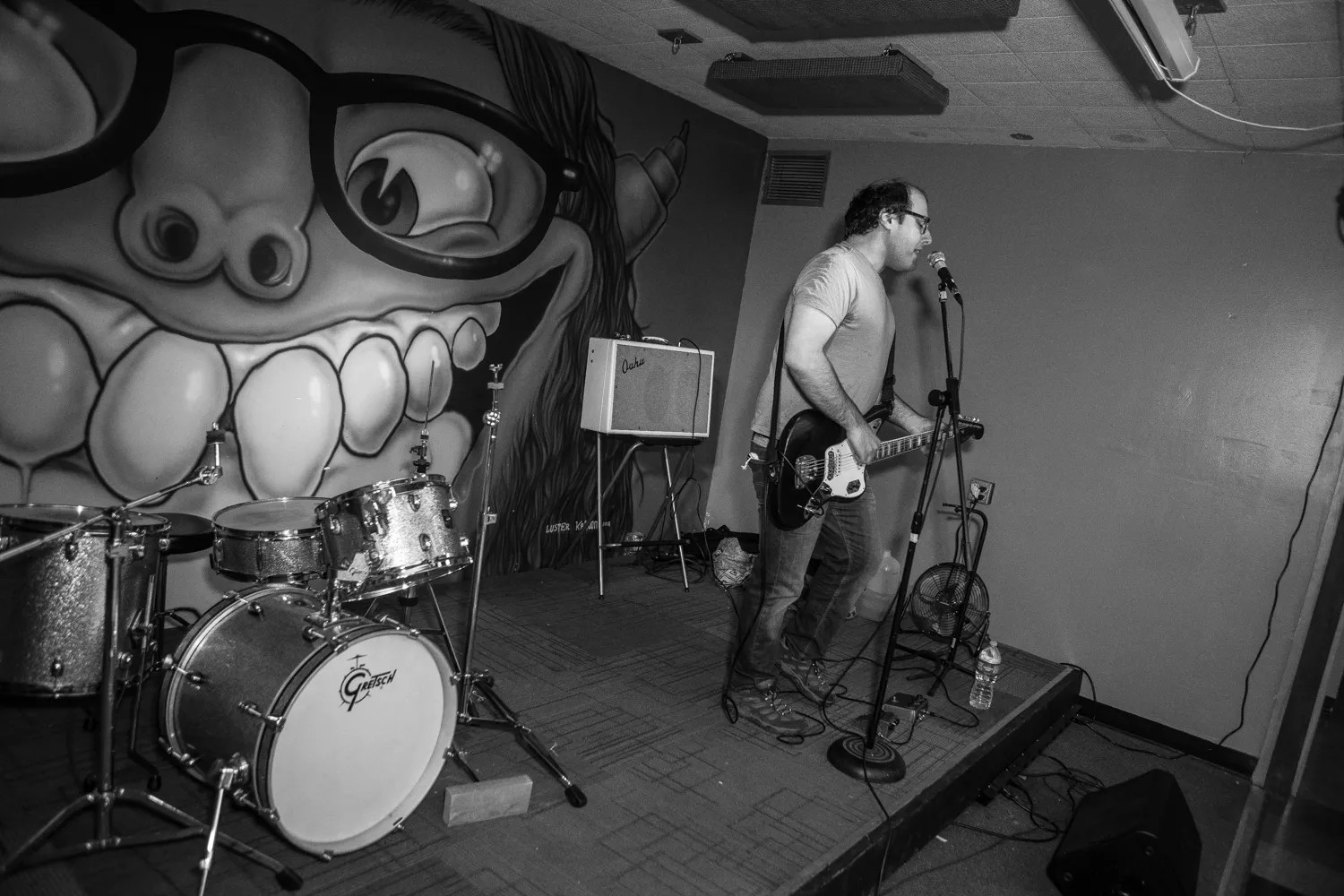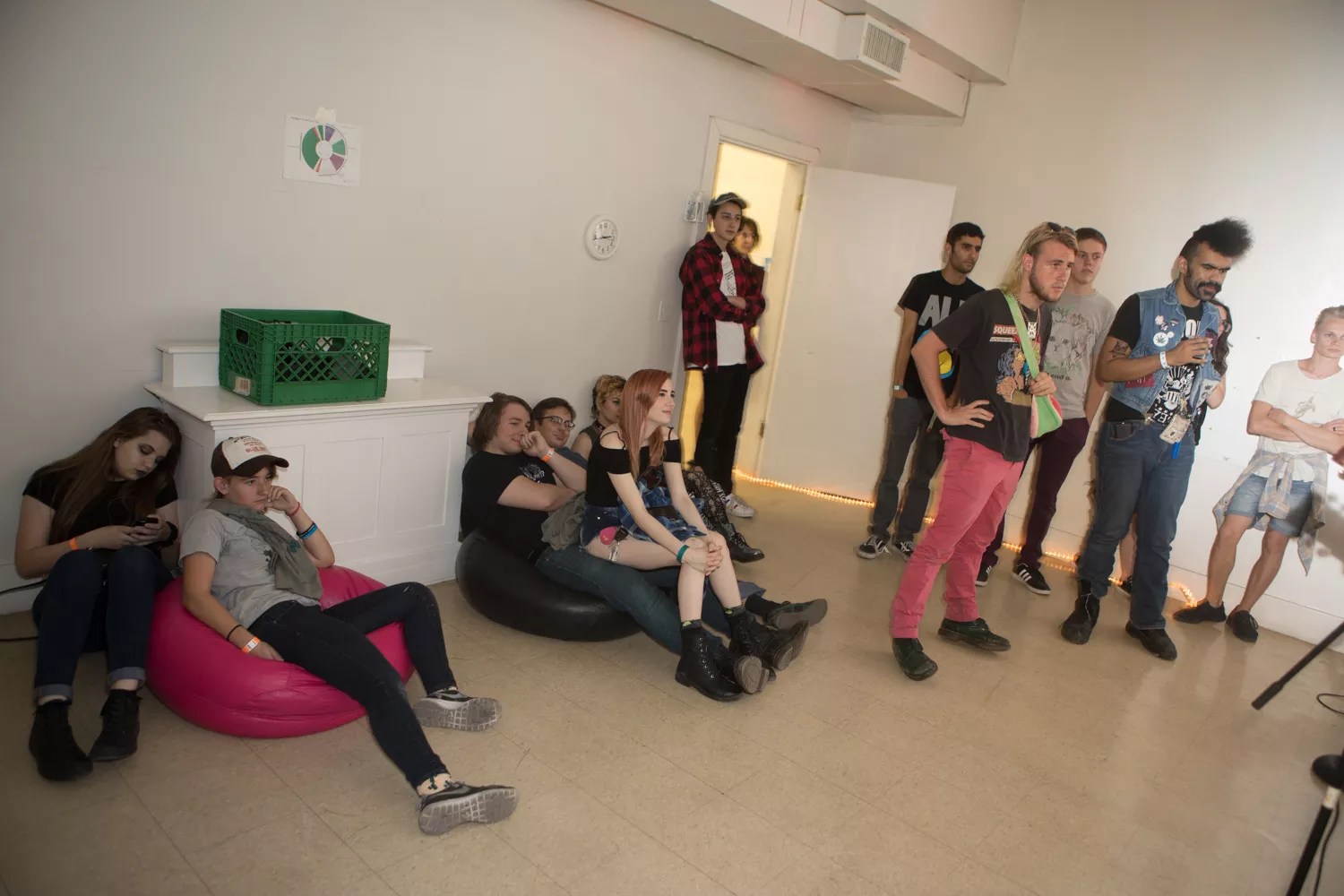
Jim Louvau.

Audio By Carbonatix
Most stupid ideas have a minuscule shelf life, like the time they tried calling Christown just “Spectrum Mall,” for example. But then there’s the local Indie 500, an event now in its sixth year that even its promoters/creators are no longer entirely sure about.
“It’s this huge labor of love, but it’s kinda stupid doing it year after year,” says organizer Ryan Avery. “But people get really excited, and now we just have to do it. I just don’t want to disappoint anyone, even a dozen people.”
The premise is simple enough: 100 bands spend almost two full days performing 500 songs consecutively across the stages at Phoenix’s Trunk Space. However, the event wasn’t always so daunting. The first go-round occurred over 10 nights (five bands performing 10 songs nightly). But around the second year, someone with Trunk Space’s board of directors had an epiphany to condense the format.
“It became a mess, and we didn’t want to do it after the third year,” adds Avery. “It was just super stressful to organize.” As such, Avery makes clear that this is no mere festival but a “musical marathon.”
But the talent doesn’t always agree. Local folk-punk musician Andy Warpigs, who has performed at every edition, called the 500 the “Phoenix equivalent of Woodstock; [it’s] this loose, crazy thing. It’s a physical strain but the sheer artistic experience alone is worth it.”
He adds that events like these are crucial for the local scene to fully engage the next crop of eager young fans and musicians. “There was a fest at Phoenix College like seven years ago, and that’s how I saw AJJ for the first time. That’s how I discovered a lot of music as a youngster.”
Avery also highlights appearances by indie star Kimya Dawson from a couple of years back. Promoters booked several young or up-and-coming acts around her set, which helped boost their respective profiles as well as overall attendance in a genuinely organic display of the event’s potential.
Owen Evans, of the band RÁ˜Á…R, agrees with Warpigs regarding the 500’s value to the local scene. He says that the event, in general, is an effective way to generate attention and good energy.
“I love it, but even if I’m not participating, it’s comforting,” he says. “You show up and you’re around two other people, and maybe you’re not stoked, but you might bear witness to something special. Even if you go home, and it’s going on, you’re still part of it.”
Evans says that Trunk Space is a perfect setting. “Even when it’s crowded, the 500 is still nice. It’s got a good range of bigger and less popular acts. You’re just more likely to feel intangible; it’s like a mega-intimacy.”
Yet such lofty aspirations means a logistical feat of strength, and organizers are continually exploring new ways to streamline efforts. This is the second year the 500 will feature “hall monitors,” volunteers decked out with sashes to help answer questions and move the festivities along. It also helps that they went from three stages to two, even though that change isn’t entirely set in stone.
Also in 2018, the board came up with a novel idea: recruit friends and performers to promote their showcases, programming blocks of 100 or so minutes. Avery says that it was so effective, last year’s event ran less than 20 minutes behind, a massive accomplishment among indie rock concerts.
Jessie Demaree, whose band Jerusafunk has played the event in prior years, says bands immediately noticed the change, adding, “It used to be 100 bands communicating with just Ryan, and now it’s one person communicating with five bands.”

Kinnikinnick on stage at 2017’s Indie 500 event.
Jim Louvau
There’s also the matter of time slots; the most desired space is on Friday evening, and that competition sometimes drums up the worst in participating bands.
“The most difficult time for people to commit is 5 a.m. to 10 a.m.,” Avery says. “That’s when most people like to sleep. We’ve had bands have this shitty attitude for playing weird times, but I always tell them you’re never playing to no one. Even if it’s 10 people.”
Curation is another concern. Avery says he likes to “think strategically” and ensure “everything makes sense sonically” when booking his block, which is why he drifted toward “mellower” acts like Dinosaur Love and Golden Boots. Warpigs is scheduling the first block this year. He says he’s opted for a collective of local folk-punk acts he frequently books.
A lack of curation, as Avery explains, can prove problematic. “It was maybe year three, and there was some techno EDM, then a noise act, and then pop-punk,” he explains. “Nobody wants to hear that at 6 or 7 in the morning. If you’re gonna do noise and ambient, it’s got to be when those types of weirdos are up.”
The event itself is a deliberate spectacle to some degree. It’s an excuse to do something crazy for the sake of it all. Yet as Avery explains, the event’s also built to illicit great creative moments.
“My old band, Drunk and Horny, played a couple years ago,” he says. “And we’d play a minute or so before the bands, and we wanted people to follow us around different parts of the property. A couple people still did follow us around.”
Similarly, Demaree says that the 500 has become a spot for local creators and devotees to “mingle,” and that she’s taken on the role of “matriarch” to help younger artists understand the scene and deal with their very first experiences in playing in a band.

A crowd shot from Indie 500’s event in May 2017.
Jim Louvau
But more than just uplifting the local scene, Demaree says that the 500 is a way to compete with other big cities from a cultural standpoint.
“There’s not always shows to see at 5 in the morning,” she says. “This isn’t Los Angeles or New York. So it’s very refreshing.”
So, for those who plan to attend, what tips do the pros have to share? Demaree highlights the obvious advice, like staying hydrated and “bringing a pillow and blanket for quick naps.” (Warpigs uses his car to “take micro-naps” like a surgeon.) Evans, meanwhile, says to treat the event like a kind of sampler platter, where you can “get a wide scope of the scene in a short-ish time.”
Finally, come with an open mind. Most of the participants expressed sincere hopes that people, performers or otherwise, use the 500 as a means to try and experience new bands and forms of expression.
“You’ve definitely got to do something different to get people up at 7 a.m.,” Warpigs says. “Like, costumes and shit you wouldn’t otherwise. Everyone has a core base of supportive friends, but go outside your comfort zone and give someone a chance. It’s a little like Alice in Wonderland: peek in, have a tumble, and meet all the weird people.”
The Sixth Annual Indie 500 runs from Friday, September 20 at 4 p.m. through Sunday, September 22 at 1 a.m. at the Trunk Space, 1124 North Third Street. Participating bands include Mouse Bird Dog, Closet Goth, Meet The Sun, Little Hands, Sad Dance Party, Eons, Brian Cooper’s Ghost, Treasure Mammal, and Justin Moody. For a full roster, as well as ticket and other info, check out the event’s Facebook page.